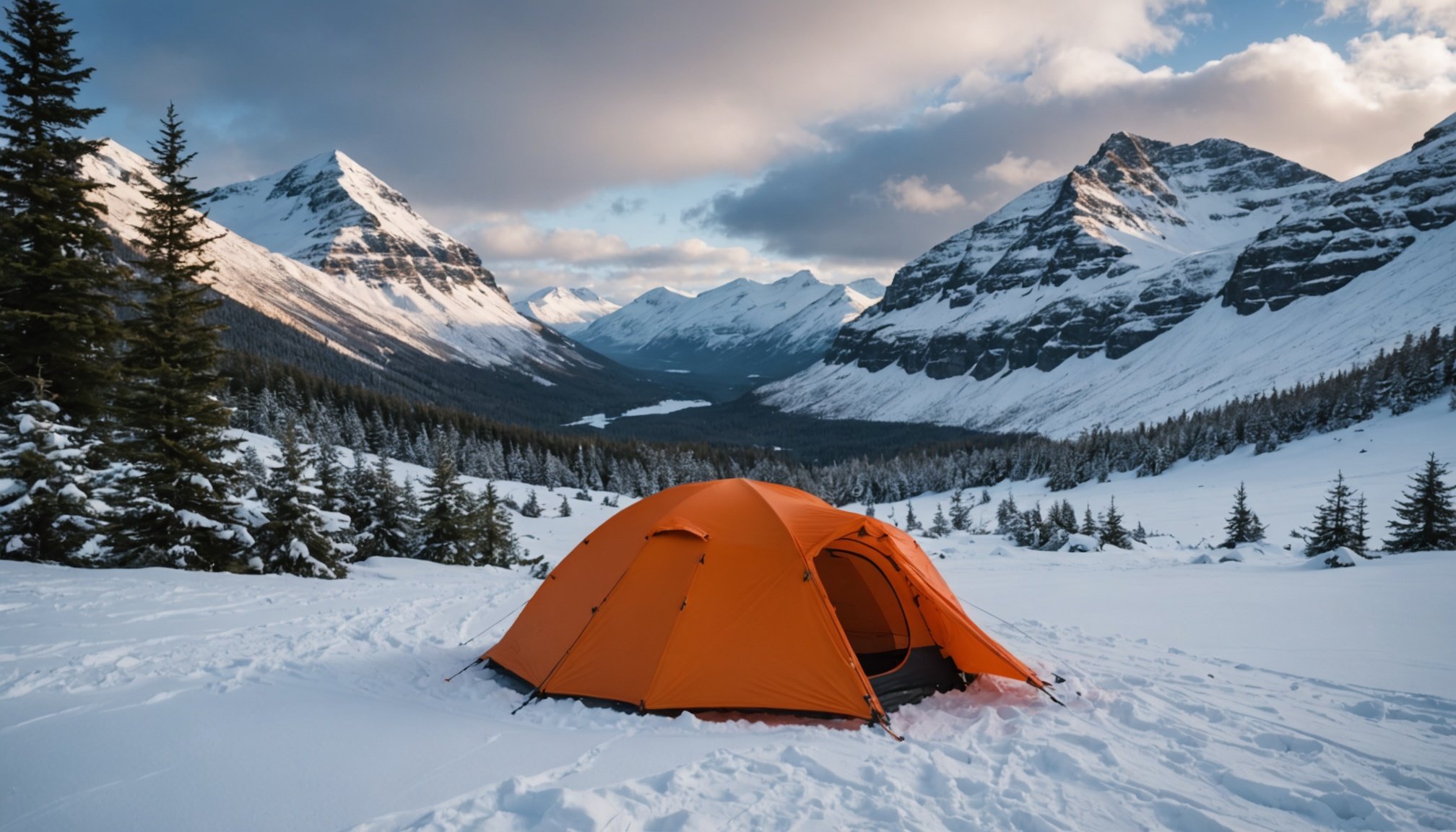Essential Gear for Winter Camping
When venturing into the frigid embrace of winter camping, ensuring you have the right gear is paramount. Proper winter camping gear not only enhances comfort but is crucial for safety. Selecting a sleeping bag designed for sub-zero temperatures is essential. Look for insulated sleeping bags with down or synthetic fills that offer excellent warmth without sacrificing packability. A thermal sleeping pad can further protect against the ground’s chill, offering much-needed insulation.
Choosing the right tent is also critical. Opt for a four-season tent, crafted to handle harsh winter conditions. These tents are constructed with robust materials that withstand snow load and high winds, ensuring cold weather equipment that keeps you sheltered.
In parallel : The complete blueprint for an unforgettable kayaking and camping expedition along the uk coastline
For cooking, compact, portable stoves are ideal. Liquid-fuel stoves typically perform better in colder environments than canister stoves. Pair this with a windscreen to conserve heat and fuel. Portable heat sources, like small, safe heaters, can also be invaluable for providing warmth in communal areas during downtime.
In summary, assembling a kit of essential outdoor gear is not merely about convenience, but a fundamental strategy to maximize warmth, safety, and enjoyment during winter camping adventures. Prioritize well-insulated sleeping gear, durable tents, and efficient cooking solutions to make your winter camping experience as seamless as possible.
Also read : Escape the digital world: discover the best campsites in the uk for your perfect detox retreat
Safety Precautions and Considerations
Winter camping presents unique challenges, so adhering to winter safety tips is critical. Recognizing the signs of hypothermia, such as uncontrollable shivering and coordination loss, is vital. Cold weather can swiftly impact your body, and knowing hypothermia prevention techniques can be life-saving. Always dress in layers, avoid getting wet, and ensure you have access to a heat source.
Frostbite is another risk in frigid environments, primarily affecting fingers, toes, nose, and ears. Prevention focuses on keeping exposed skin covered and staying dry. If signs of frostbite occur, such as skin becoming pale or hard, gently warm the area without rubbing as rubbing can cause tissue damage.
Navigation and emergency preparedness are paramount in winter landscapes where paths can be hidden beneath snow. Equip yourself with a GPS device or a map and compass, and understand how to use them. Always inform someone of your route and expected return time in case of an emergency.
Being aware of wildlife hazards, even in winter, is important. Animals may be less visible but can still pose threats. Familiarize yourself with the local wildlife and store food securely to prevent unwanted encounters.
Staying Warm and Comfortable
Staying warm outdoors during winter camping requires strategic planning and gear selection to ensure comfort throughout your adventure. Prioritizing winter camping comfort starts with effective layering techniques. Wear a moisture-wicking base layer to pull sweat away from your skin, followed by an insulating mid-layer, like fleece or wool, to retain body heat, and a waterproof outer layer to protect against wind and moisture.
Layering Techniques
Employing a three-layer system is crucial. This combination helps manage temperature and moisture, allowing you to adjust layers according to activity level and weather conditions, ensuring optimal warmth and comfort.
Insulating Your Tent
To enhance warmth within your tent, consider additional cold weather tips. Use a groundsheet under your tent for an extra moisture barrier. Adding a tent carpet or additional insulated mat can also increase comfort and insulation.
Tips for Maintaining Body Heat
Maintaining heat is equally crucial. Consume warm meals and beverages to raise your core temperature. Simple habits, such as aerobic exercise before sleep, can stimulate circulation and warmth. Remember to keep hydrated and fueled, as this aids in generating body heat. By following these cold weather tips, you can transform your camping experience from merely tolerable to delightfully snug.
Choosing the Right Campsite
Selecting the perfect winter camping site involves more than just finding a scenic spot. Begin by evaluating the terrain for stability and snow depth. Opt for areas that offer natural windbreaks like dense tree lines, which can provide shelter against prevailing winds. An elevated campsite can prevent pooling water but ensure it’s not too exposed to harsh gusts.
Understanding snow conditions is crucial. Hard-packed snow ensures a solid base for tents and reduces the risk of unexpected collapses. Yet, always use caution with snow-heavy branches overhead, which might pose a risk.
Access to resources is also significant. Before heading out, leverage online platforms and local maps to find recommended winter camping locations. Consider proximity to trails or emergency routes, which adds a layer of safety.
When choosing a site, check for any existing campfire pits to minimize environmental impact. Lastly, be mindful of sensitive wildlife habitats, ensuring your presence does not disturb the natural setting. By carefully considering these elements, your winter camping adventure will be both safe and enjoyable.
Meal Planning for Cold Weather
Proper food planning is a cornerstone of winter camping, ensuring both nutrition and warmth. When selecting winter camping meals, high-energy options are crucial. Carbohydrate-rich foods provide quick energy, while fats offer sustained fuel for prolonged cold exposure. Pack dried fruits, nuts, and energy bars for convenient, nutrient-dense snacks.
Cooking in cold temperatures presents its own set of challenges. Wind can sap a stove’s efficiency, so using a windscreen is essential to conserve heat. Opt for winter-friendly cooking equipment, like liquid-fuel stoves that perform optimally in low temperatures. Pre-chopped ingredients and meals that require minimal preparation help conserve heat and time in chilly conditions.
Storing food properly is vital to prevent freezing and spoilage. Insulated bags or a cooler, surprisingly, can both retain some warmth when packed with hot water bottles. This keeps crucial foodstuffs, especially fresh produce, from becoming a frozen block overnight. Always plan meal portions with precision to avoid excess pack weight and unnecessary waste.
In cold weather, staying hydrated can be easily overlooked. Carry a thermal flask for hot drinks that double as a hand-warming tool. By organising your camping food preparations carefully, you’ll ensure every meal is both an energy booster and a comfort in the midst of winter’s harsh embrace.
Weather Considerations for Winter Camping
Navigating the challenges of winter camping requires understanding winter weather effects. Effective planning involves staying updated with weather forecasts—knowing potential temperature drops and snow accumulation ensures you’re prepared for sudden changes. To interpret forecasts for camping in the cold, familiarise yourself with terms like wind chill and temperature inversions, which can drastically alter perceived conditions.
When temperatures plummet, having strategies to cope is crucial. Begin with a robust weather preparedness plan that includes extra clothing layers, reliable heat sources, and ample nutritional supplies. Layering helps adapt to fluctuating temperatures, ensuring warmth and comfort. Preparing a heated communal space allows temporary relief from the chill, making downtime more bearable.
In extreme weather, knowing how to construct makeshift shelters or windbreaks using tarps or available natural resources can provide immediate protection. Ensure tent stakes and guy lines are secure against harsh winds and consider carrying extra stakes or sandbags for additional stability.
Understanding winter weather effects and having a weather preparedness plan is vital to maintaining safety and comfort. Embracing these strategies not only helps you persist through unexpected conditions but enhances the overall enjoyment of your winter camping experience.
Packing List for Winter Camping
Preparing a comprehensive winter camping checklist is vital for ensuring a successful and safe outdoor experience. Start by listing packing essentials like layered clothing designed for cold environments. Opt for moisture-wicking base layers, insulating mid-layers, and a protective outer layer to combat the elements effectively. Invest in quality gloves, hats, and insulated boots to keep extremities warm.
Next, include crucial camping gear such as a four-season tent and a reliable sleeping system. An insulated sleeping mat paired with a sub-zero sleeping bag is recommended for optimal warmth and comfort during cold nights. Remember to pack a compact stove with suitable fuel, windscreen, and basic cooking utensils to prepare meals efficiently.
For food and hydration, plan high-calorie and nutrient-dense meals that cater to the increased energy demands of winter activities. Carry a thermal flask for hot drinks which double as hand-warmers, and ensure water supplies are kept from freezing by maintaining an insulated container.
Lastly, anticipate adverse weather by packing emergency gear such as a first-aid kit, a multi-tool, and a sturdy shovel for snow. A well-organised packing list ensures you’re equipped to handle and enjoy the rigours of winter camping fully.










